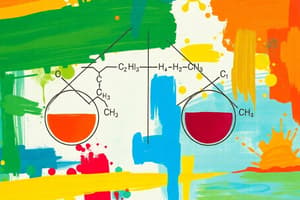Podcast
Questions and Answers
ما هدف توازن المعادلات الكيميائية؟
ما هدف توازن المعادلات الكيميائية؟
- زيادة عدد الذرات على الجانب الأيمن من المعادلة
- تقليل عدد الذرات على الجانب الأيسر من المعادلة
- تحقيق قانون الحفاظ على الكتلة (correct)
- زيادة عدد الإلكترونات في المعادلة
ما هو الخطوة الأولى في توازن معادلة كيميائية؟
ما هو الخطوة الأولى في توازن معادلة كيميائية؟
- عد الذرات (correct)
- زيادة عدد المواد
- التحقق من كمية الإلكترونات
- تغيير المعاملات
ما هو التغيير الذي يحدث لمعامل O2 في المعادلة \[ H2 + O2 -> H2O ] بعد توازنها؟
ما هو التغيير الذي يحدث لمعامل O2 في المعادلة \[ H2 + O2 -> H2O ] بعد توازنها؟
- 1
- 4
- 2 (correct)
- 3
ما هو التغيير الذي يجب إجراؤه في المعادلة \[ H2 + O2 -> H2O ] لتوازن كمية الأكسجينات؟
ما هو التغيير الذي يجب إجراؤه في المعادلة \[ H2 + O2 -> H2O ] لتوازن كمية الأكسجينات؟
ماذا يعني توازن المعادلة الكيميائية؟
ماذا يعني توازن المعادلة الكيميائية؟
ما هو التحديث النهائي الذي يجب إجراؤه بعد تغيير المعاملات لضمان توازن المعادلة؟
ما هو التحديث النهائي الذي يجب إجراؤه بعد تغيير المعاملات لضمان توازن المعادلة؟
كيف يتم حل المعادلة الكيميائية باستخدام التعديل؟
كيف يتم حل المعادلة الكيميائية باستخدام التعديل؟
إذا كان لدينا معادلة كيميائية متوازنة بشكل كامل، فما هو الحال؟
إذا كان لدينا معادلة كيميائية متوازنة بشكل كامل، فما هو الحال؟
ما هو الشيء الذي قد يستدل عليه وجود مشكلة في توازن المعادلة الكيميائية؟
ما هو الشيء الذي قد يستدل عليه وجود مشكلة في توازن المعادلة الكيميائية؟
متى يحتاج بعض التفاعلات إلى استخدام معاملات كسرية لتحقيق التوازن؟
متى يحتاج بعض التفاعلات إلى استخدام معاملات كسرية لتحقيق التوازن؟
Study Notes
Balancing Chemical Equations
Balancing chemical equations involves changing the coefficients of the reactants or products in a chemical reaction until the number of atoms of each element is the same on both sides of the equation. This process ensures that the law of conservation of mass is obeyed, as the total mass of the reactants must equal the total mass of the products. Let's explore the steps involved in balancing a chemical equation.
Step 1: Count the Atoms
First, count the number of atoms of each element on both the reactant and product sides of the equation. For example, consider the reaction:
[ \ce{H2 + O2 -> H2O} ]
On the reactant side, there are 2 hydrogen atoms and 2 oxygen atoms. On the product side, there are 2 hydrogen atoms and 1 oxygen atom.
Step 2: Change the Coefficient
Next, choose one of the substances and change the coefficient (the number in front of the formula) to balance the atoms. In our example, we can change the coefficient of O2 to 2:
[ \ce{H2 + 2O2 -> 2H2O} ]
Now, the number of oxygen atoms is the same on both sides: 2.
Step 3: Count the Atoms Again
Finally, count the number of atoms of each element again to ensure that the equation is balanced. In our example, there are still 2 hydrogen atoms and 2 oxygen atoms on each side.
Balancing a More Complex Equation
Let's consider a more complex reaction:
[ \ce{H2 + O2 -> H2O + CO2} ]
First, count the atoms:
- On the reactant side: 2 hydrogen atoms, 2 oxygen atoms
- On the product side: 2 hydrogen atoms, 2 oxygen atoms, 1 carbon atom
Now, change the coefficient of H2O to 2:
[ \ce{H2 + O2 -> 2H2O + CO2} ]
Count the atoms again:
- On the reactant side: 2 hydrogen atoms, 2 oxygen atoms
- On the product side: 4 hydrogen atoms, 4 oxygen atoms, 1 carbon atom
Since the number of hydrogen and oxygen atoms is the same on both sides, the equation is balanced for these elements. However, there is still an imbalance in the number of carbon atoms. To balance the carbon atoms, change the coefficient of CO2 to 2:
[ \ce{H2 + O2 -> 2H2O + 2CO2} ]
Now, the number of carbon atoms is the same on both sides: 1.
Balancing Equations with Fractional Coefficients
Sometimes, balancing a chemical equation might require fractional coefficients. For example, consider the reaction:
[ \ce{Na + Cl -> NaCl} ]
Count the atoms:
- On the reactant side: 1 sodium atom, 1 chlorine atom
- On the product side: 1 sodium atom, 1 chlorine atom
Since the number of sodium and chlorine atoms is the same on both sides, the equation is already balanced for these elements. However, the equation is not balanced for the total mass. To balance the equation, multiply both sides by 2:
[ 2\ce{Na + 2Cl -> 2NaCl} ]
Now, the equation is balanced for the total mass as well.
In conclusion, balancing chemical equations involves changing the coefficients of reactants or products to ensure that the number of atoms of each element is the same on both sides of the equation. By following these steps and making necessary adjustments, you can balance any chemical equation according to the law of conservation of mass.
Studying That Suits You
Use AI to generate personalized quizzes and flashcards to suit your learning preferences.
Description
Learn the step-by-step process of balancing chemical equations to ensure that the law of conservation of mass is obeyed. Explore techniques for counting atoms, changing coefficients, and balancing more complex equations, including dealing with fractional coefficients. Practice balancing equations to master this fundamental skill in chemistry.




